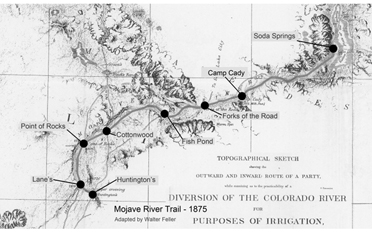Independence
When Mexico finally gained independence in 1821, she assumed some of the same liabilities in the northern frontiers that had plagued Spain: Indians, communication, trade, and loyalty. Even though Mexico had in almost incessant internal struggle, she was able to alleviate some of her trade problems in the north. The trades restrictions were liberalized, allowing foreigners to sell products with permits and moderate tariffs. The number of ships stopping at California ports increased. New Mexico added depth to its trade with the United States via the Santa Fe Trail. The United States Congress even helped by appropriating $10,000 for the Missouri-Santa Fe Rd. and $20,000 for the right of way through the Indian territory. Work on the road began in 1825 and was completed in 1828. Trappers and Indian traders began to use Taos and Santa Fe as supply depots. The Mexican silver peso was on a par with the United States dollar and was more in circulation in western Missouri than the United States dollar. The growth in trade may also be seen in the following chart showing the volume of goods, wagons, and men sent to New Mexico:| Year | Goods | Wagons | Men |
| 1822 | $15,000 | 0 | 70 |
| 1825 | $65,000 | 37 | 130 |
| 1828 | $150,000 | 100 | 200 |
The opening of the Mojave River Trail segment of the Old Spanish Trail was embodied in the history of the trappers. This dauntless breed of men moved around the West like a dynamic tide flooding into all the un-trapped hunting areas. They risk their lives for the chance of netting $200-$1000 a year, and for adventure. An individual might participate in a trapping expedition as an independent trapper or as an employee. The independent or free trapper under William Wolfskill in 1830 1831, for example, received five dollars for each beaver pelt; but he had to pay $2.50 for a share of four beeves and $4.50 for a share of two horses when the diet so necessitated. He had to pay a dollar 50 a pound for tobacco and gunpowder; for glad, $.50; gun flints, three cents; balls, 12 ½ cents; Combs, $.50; so, $.25; shirts, $1-$3; and Jews-harps, $.25. The free trappers traded these commodities with Indians for skins. The employee, on the other hand, either received a share of the profits or a set salary. Wolfskill paid David Keller: "In service from Taos to California $91.93 and three quarter cents"; Blaise Greago [sic], eight dollars per month; and José Archulate, seven dollars a month for 3 and one-half months.
< Previous - Next >
Barring Interferences & Calamities
Successful Trading
Mission San Gabriel
This Illustrious Group
The Chastised Mohave
Another Band of Hunters
Deception
Movements through the Mojave
Finding a New Route
The Race for Profits

Mojave River Trail